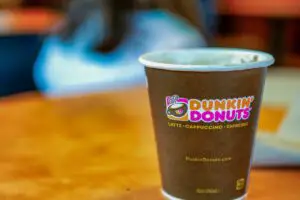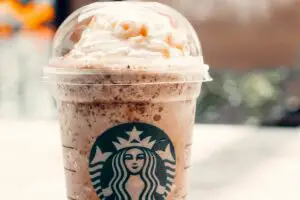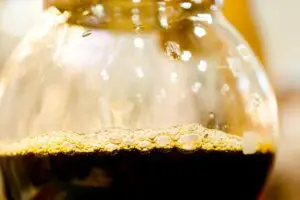*This post may contain affiliate links. As an Amazon Associate we earn from qualifying purchases.
It was a cold, Monday morning. My kids, who never seemed to run out of energy, were already in full swing, my eyes were only half-open, and I was trying to remember if it was humanly possible to mainline caffeine.
If you’re a fellow coffee addict, you know the feeling. That desperate, almost primal need for caffeine. And if you’re a parent, you understand the struggle of running on 3 hours of sleep because your youngest suddenly decided that sleep was for the weak.
Now, imagine those two scenarios combined. That’s my life. So, you bet your latte that when I saw that bottle of Starbucks iced coffee in my fridge, it was like a chorus of angels started singing.
But then, my heart sank. The ‘best by’ date. It was two days ago. I could practically hear the record scratch in my head. You know that moment in the horror movies when the music gets all intense and then suddenly stops?
Yeah, that was me, holding that bottle of iced coffee like it was a live grenade.
So, knowing how long you can drink Starbucks iced coffee after the “best by” date on the bottle is vital info! This isn’t just some theoretical question in the mind of an overly caffeinated, sleep-deprived mom of three kids. This is a matter of survival.
Or at least, of staying awake long enough to prevent the 5-year-old from painting the dog again.
We’ve all been there, haven’t we? Wondering if that date on the packaging is more of a gentle suggestion or a hard stop. So, let’s embark on this journey together, to the land of caffeine and beyond, and find out the truth.
If your bottled Starbucks coffee is past its best-by date it will still be safe to drink but it might not taste as good as it once did. A Starbucks iced coffee that is past the best-by date isn’t unsafe to use it just might not be as fresh or tasty as it once was.
So you can still drink a bottled Starbucks Frappuccino or Espresso past the best-by date. However, the quality just won’t be as much as if you use it before the date on the bottle or can.
Stay tuned for the next section, where we’ll dive into the mysterious world of food expiration dates. You’ll learn the shocking truth about ‘best by’, ‘sell by’, and ‘use by’ dates, and why they’re not as scary as they seem. So grab your coffee (hopefully not expired) and keep reading because things are about to get brewing!
Key Takeaways:
- ‘Best by’, ‘sell by’, and ‘use by’ dates are guidelines for food quality and freshness, not safety.
- Starbucks iced coffee past its ‘best by’ date is still safe to drink but may not taste as fresh or flavorful.
- Coffee deteriorates over time due to factors like oxidation, moisture, light, and heat.
- Signs of deterioration in iced coffee include changes in taste, smell, and appearance.
- Unopened Starbucks iced coffee can last 7 to 10 days past the ‘best by’ date if stored properly in the fridge.
- Once opened, Starbucks iced coffee should be consumed within 2 to 3 days.
- Consuming spoiled iced coffee can lead to food poisoning or foodborne illnesses.
- Proper storage, such as refrigeration and sealing, can extend the shelf life of Starbucks iced coffee.
- If in doubt, use your senses to determine if the iced coffee has gone bad.
Understanding Food Expiration Dates
Now, to understand the whole kerfuffle with that ‘best by’ date on my iced coffee, we first have to dip our toes into the riveting world of food expiration dates. Now, hold onto your coffee cups, my friends, because this might just be the most exciting thing you read today.
‘Best by’, ‘sell by’, and ‘use by’ dates are like the cryptic messages of the food world. They’re not quite Morse code, but might as well be for all the confusion they cause.
- ‘Best by’: This little date is all about quality, not safety. Imagine it like a warranty for your food. After this date, the manufacturer can’t vouch for the peak quality of the product, but it doesn’t mean you’ll keel over if you eat it.
- ‘Sell by’: This is a sneaky little note to the retailers, not us consumers. It’s the date by which the product should be sold or removed from the shelf. But don’t worry, it doesn’t turn into a pumpkin at midnight.
- ‘Use by’: This is the real deal. It’s like the boss level of food expiration dates. It’s primarily for perishable goods and you want to pay attention to this one.
Now, here’s a handy table to make things a bit easier:
| Date Type | Meaning | Safety or Quality? |
|---|---|---|
| Best By | Peak quality until this date | Quality |
| Sell By | Should be sold or removed from shelf by this date | Quality |
| Use By | Last date recommended for use while at peak quality | Safety |
Now that we’ve deciphered these cryptic codes, let’s mosey on over to the science behind coffee deterioration. Because yes, coffee is a science. And no, it’s not just because we need it to function.
The Science behind Coffee Deterioration
Let’s continue our caffeinated journey by diving into the nitty-gritty of coffee deterioration. Now, if you thought your teenager’s room was a science experiment, wait until you hear about what happens to coffee over time.
Like any other food product, coffee goes through changes as it ages. It’s not maturing like a fine wine, but more like turning into that weird cheese you forgot at the back of the fridge. Here’s what’s happening behind the scenes:
- Oxidation: When coffee is exposed to air, it starts to oxidize. It’s a bit like when you cut an apple and leave it out. It turns brown and not-so-appetizing, right? Oxidation is the coffee equivalent of that, except it doesn’t turn brown because, well, it already is.
- Moisture: Moisture is coffee’s mortal enemy. The moment your coffee comes into contact with any form of moisture, you might as well start planning its funeral. Moisture speeds up the degradation process, leading to mold and bacteria growth. And no one wants a side of E. coli with their morning cuppa.
- Light and Heat: Coffee is a bit like a vampire. It hates light and heat. These two factors can cause your coffee to go stale faster than you can say “double shot espresso”.
So, what are the signs of deterioration in iced coffee?
- First, there’s the change in taste. You know that delightful, robust flavor that makes you feel like you can conquer the world (or at least get through the school run)? Yeah, that’s gone. Instead, you’re left with something that tastes like despair and regret.
- Then, there’s the smell. Fresh iced coffee smells like hope and happiness. Spoiled iced coffee smells like your dreams of a peaceful morning have been crushed.
- Lastly, there’s the appearance. If your iced coffee looks more like a science experiment than a refreshing beverage, it’s probably time to say goodbye.
Starbucks Iced Coffee: Ingredients and Preservation
Now that we’ve had our little science lesson, let’s take a closer look at our hero – the Starbucks iced coffee. What makes it different from, let’s say, the iced coffee you attempted to make that one time during the DIY trend of 2020?
First, the ingredients. Starbucks iced coffee isn’t just coffee and ice. It’s a blend of premium coffee, filtered water, and some food additives to maintain its quality. It’s the Beyoncé of iced coffee – all glammed up and ready to go.
The preservation methods used by Starbucks are like the secret sauce. They use techniques like pasteurization and special packaging to extend the shelf life of their iced coffee.
It’s like they put their iced coffee in a little time capsule, keeping it fresh and tasty for longer.
But you know what they say, all good things must come to an end. And that includes the freshness of Starbucks iced coffee. Which brings us to our next burning question: how long does Starbucks iced coffee last past the ‘best by’ date?
Spoiler alert: it’s longer than your kid’s attention span. But to find out just how long, you’ll have to stick around for the next section. And trust me, it’s going to be brew-tiful!
How Long Starbucks Iced Coffee Lasts Past the ‘Best By’ Date
So, we’ve reached the moment of truth. The question that’s been keeping you on the edge of your seat – How long does Starbucks iced coffee last past the ‘best by’ date?
The answer, my dear caffeine aficionados, depends on a couple of factors:
- Storage conditions: If you’ve been keeping your iced coffee in the fridge, snuggled up between the leftover pizza and the questionable yogurt, you’ve done well. Starbucks iced coffee is like a spoiled cat – it prefers a cool, dry place.
- Packaging: Did you open it? If you did, the clock starts ticking much faster. An unopened bottle of Starbucks iced coffee can last much longer than an opened one. It’s like a can of worms – once you open it, there’s no going back.
Now, let’s talk numbers. An unopened bottle of Starbucks iced coffee can last about 7 to 10 days past its ‘best by’ date if properly stored in the fridge.
On the other hand, an opened bottle should be consumed within 2 to 3 days. So, if you’re the kind of person who savors their coffee, maybe stick to buying smaller bottles.
Signs Your Starbucks Iced Coffee Has Gone Bad
So, how do you tell if your iced coffee has taken a turn for the worse? Here are some surefire signs:
- Smell: If your coffee smells like it’s plotting your demise, it’s time to let it go.
- Taste: A sip of spoiled iced coffee will taste like betrayal. Bitter, sour, and nothing like the refreshing drink you were hoping for.
- Appearance: If you see any signs of mold or cloudiness, that’s a red flag. Your iced coffee should be as clear as your resolve to get through the day without losing your sanity.
Health Implications of Consuming Expired Iced Coffee
Now, if you’ve been playing Russian roulette with your Starbucks iced coffee and the ‘best by’ date, you might be wondering – what’s the worst that could happen?
Well, consuming spoiled iced coffee can lead to food poisoning. You might experience symptoms like nausea, vomiting, diarrhea, and stomach cramps.
It’s like a hangover, but without the fun memories from the night before.
In extreme cases, you might also get a foodborne illness. This is when things get serious. We’re talking high fever, severe stomach cramps, bloody diarrhea, and even hospitalization. So, remember, folks, it’s better to be safe than sorry!
Tips for Storing Starbucks Iced Coffee to Extend its Shelf Life
Want to make sure your Starbucks iced coffee stays fresh for as long as possible? Here are some tips:
- Keep it in the fridge: Starbucks iced coffee loves the cold. It’s like a penguin – it thrives in cooler temperatures.
- Seal it properly: If you’ve opened your iced coffee, make sure you seal it properly before putting it back in the fridge. This will prevent any air or bacteria from getting in and spoiling the coffee.
- Avoid cross-contamination: Don’t pour your coffee into a used cup or use a dirty spoon to stir it. This could introduce bacteria into the coffee and speed up the spoiling process.
So, there you have it, folks! Everything you need to know about the life and times of Starbucks iced coffee.
And remember, life’s too short to drink bad coffee!
How to Make Your Own Iced Coffee at Home
But what if you’re in a pinch and your trusty Starbucks iced coffee has turned to the dark side? Fear not, dear caffeine lovers, because I’m about to share the secret to making your own iced coffee at home.
Step 1: Brew Your Coffee: Start with a strong brew because no one has ever said, “This coffee is too strong,” and meant it.
Step 2: Let it Cool: Patience is a virtue, and it also stops you from getting third-degree burns. Let your coffee cool down before you proceed.
Step 3: Ice, Ice, Baby: Get a glass, fill it with ice, and pour in the coffee. The order is important unless you want a coffee-flavored ice cube.
Step 4: Add Ins: This is where you get to play barista. Add some milk, sugar, flavored syrup, or whatever tickles your fancy.
Step 5: Enjoy: Sit back, take a sip, and pretend you’re in a fancy coffee shop instead of your kitchen.
Conclusion
Well, we’ve been on quite a journey, haven’t we? We’ve cracked the code of food expiration dates, dived into the world of coffee deterioration, and even learned how to whip up our own iced coffee. But most importantly, we’ve answered the question that haunts every coffee lover’s dreams – “How long can I drink Starbucks iced coffee after the ‘best by’ date?”
Remember, folks, when it comes to coffee, freshness is king. So, keep your Starbucks iced coffee chilled, sealed, and away from the light.
And when in doubt, trust your senses. If it smells funky, looks suspicious, or tastes like disappointment, it’s probably time to say goodbye.
Now, go forth and conquer the day with your caffeinated knowledge. And remember, no matter how tough the day might seem, there’s always coffee. Stay brew-tiful, my friends!
That’s the end of our journey today, folks. I hope you’ve enjoyed this whirlwind tour of the Starbucks iced coffee world as much as I have. But most of all, I hope you feel a little more confident navigating the ‘best by’ dates on your favorite Starbucks products.
So, here’s to fresh coffee, survival, and the occasional mad dash to the bathroom. Cheers!









